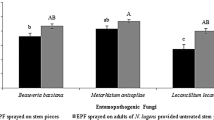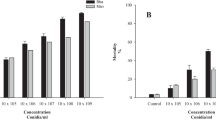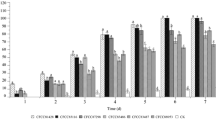Abstract
In China, the fall webworm, Hyphantria cunea, causes enormous losses. The potential of entomopathogenic fungi (EPF) to control pest insects has been demonstrated in the laboratory and the field. In this study, we isolated and identified EPF from the surfaces of H. cunea larvae cadavers, and we investigated their efficacy against fall webworm larvae under bioassay conditions in the laboratory. Isaria javanica BE01 conidial suspensions with concentrations between 1 × 104 and 1 × 108 conidia ml−1 were shown to have marked effects on the larval mortality (the 3rd, 4th, and 5th instar larvae) over a 15 days period. However, the effect of the instar on the mortality was not always significant, except during the late stages (10–14 days) at low concentrations (1 × 104–1 × 106 conidia ml−1) or the early stages (1–5 days) at high concentrations (1 × 107–1 × 108 conidia ml−1). Otherwise, the mortality of the 3rd and 4th instar larvae exceeded 85% at 1 × 108 conidia ml−1. The present study suggests that I. javanica BE01 is a potential biological control agent of H. cunea.



Similar content being viewed by others
References
Ajamhassani M, Sendi JJ, Zibaee A, Askary H, Farsi MJ (2013) Immunoliogical responses of Hyphantria cunea (Drury) (Lepidoptera: Arctiidae) to entomopathogenic fungi, Beauveria bassiana (Bals.-Criy) and Isaria farinosae (Holmsk.) Fr. J Plant Prot Res 53:110–118
Aker O, Tuncer C (2016) Efficacy of Metarhizium anisopliae and some entomopathogenic fungi on larvae of fall webworm, Hyphantria cunea (Drury) (Lepidoptera: Arctiidae). J Entomol Zool Stud 4:171–176
Aksoy HM, Saruhan I, Kaya Y, Ozturk M (2018) Morphological changes caused by Bacillus megaterium on adult emergence of fall webworm’s pupa, Hyphantria cunea (Drury) (Lepidoptera: Erebidae). J Agric Sci 24:539–546
Angelo IC, Fernandes EKK, Bahiense TC, Perinotto WMS, Golo PS, Moraes APR, Bittencourt VREP (2012) Virulence of Isaria sp. and Purpureocillium lilacinum to Rhipicephalus microplus tick under laboratory conditions. Parasitol Res 111:1473–1480
Bai PH, Liu BS, Jia AJ, Bai YC, Feng YR, Yu JP (2017) Research advances on biological control of fall webworm in China. China Fruits 6:65–69
Bayramoglu Z, Nalcacioglu R, Demirbag Z, Demir I (2018) Characterization of a betabaculovirus from the fall webworm, Hyphantria cunea Drury. (Lepidoptera: Erebidae), in Turkey. Biocontrol Sci Technol 28:1178–1190
Behle RW, Garciagutierrez C, Tamezguerra P, Mcguire MR, Jackson MA (2007) Pathogenicity of blastospores and conidia of Paecilomyces fumosoroseus against larvae of the mexican bean beetle, Epilachna varivestis mulsant. Southwest Entomol 31:289–295
Cao LJ, Wei SJ, Hoffmann AA, Wen JB, Chen M, Vaclavik T (2016) Rapid genetic structuring of populations of the invasive fall webworm in relation to spatial expansion and control campaigns. Divers Distrib 22:1276–1287
Celar F, Kos K (2012) Compatibility of selected herbicides with entomopathogenic fungus Beauveria bassiana (Bals.) Vuill. Acta Agric Slov 99:57–63
Cossentine J, Robertson M, Buitenhuis R (2016) Impact of acquired entomopathogenic fungi on adult Drosophila suzukii survival and fecundity. Biol Control 103:129–137
Dai YD, Yu H, Zeng WB, Yang JY, He L (2016) Multilocus phylogenetic analyses of the genus Isaria (Ascomycota, Cordycipitaceae). Mycosystema 35:147–160
Edosa TT, Jo YH, Keshavarz M, Anh YS, Noh MY, Han YS (2019) Current status of the management of fall webworm, Hyphantria cunea: towards the integrated pest management development. J Appl Entomol 143:1–10
Eun PS, Cheol KJ, Jin LS, Rong LM, Sihyeon K, Li DW, Sehyeon B, Han JH, Jun KJ, Bon KK, Young ST, Su KJ (2018) Solid cultures of thrips-pathogenic fungi Isaria javanica strains for enhanced conidial productivity and thermotolerance. J Asia Pac Entomol 21:1102–1109
Gallou A, Serna Domínguez MG, Berlanga Padilla AM, Ayala Zermeño MA, Mellín Rosas MA, Montesinos Matías R, Arredondo Bernal HC (2016) Species clarification of Isaria isolates used as biocontrol agents against Diaphorina citri (Hemiptera: Liviidae) in Mexico. Fungal Biol 120:414–423
Glass NL, Donaldson GC (1995) Development of primer sets designed for use with the PCR to amplify conserved genes from filamentous ascomycetes. Appl Environ Microbiol 61:1323–1330
Greenfield M, Gomez-Jimenez MI, Ortiz V, Vega FE, Kramer M, Parsa S (2016) Beauveria bassiana and Metarhizium anisopliae endophytically colonize cassava roots following soil drench inoculation. Biol Control 95:40–48
Gu YS, Zhang GX, Zhou ZQ, Liu RJ, Gao J, Cao XY, Han YZ (2015) Study on cohort and regular of occurrence for fall webworm in Shenyang. For Sci Technol 40:42–46
Han JH, Jin BR, Kim JJ, Lee SY (2014) Virulence of entomopathogenic fungi Metarhizium anisopliae and Paecilomyces fumosoroseus for the microbial control of Spodoptera exigua. Mycobiology 42:385–390
Itô Y, Miyashita K (1968) Biology of Hyphantria cunea Drury (Lepidoptera: Arctiidae) in Japan. V. Preliminary life tables and mortality data in urban areas. Popul Ecol 10:177–209
Komaki A, Kordalİ Ş, Usanmaz Bozhüyük A, Altinok HH, Kesdek M, Şimşek D, Altinok MA (2017) Laboratory assessment for biological control of Tribolium confusum du Val., 1863 (Coleoptera: Tenebrionidae) by entomopathogenic fungi Turkish. J Entomol 41:95–103
Lacey LA, Solter L (2012) Chapter I—initial handling and diagnosis of diseased invertebrates. In: Lacey LA (ed) Manual of techniques in invertebrate pathology, 2nd edn. Academic Press, San Diego
Li HP, Huang QX, Wang J, Li W (2015) Potential of entomopathogen Beauveria bassiana for controlling fall webworm Hyphantria cunea. Sci Silvae Sin 51:65–70
Li HY, Fu TT, Zhang Y, Lv TY, Li Y, Xu BL (2017) Effect comparison of five methods to extract fungal genomic DNA as PCR templates. Chin Agric Sci Bull 33:28–35
Luangsa Ard JJ, Hywel Jones NL, Manoch L, Samson RA (2005) On the relationships of Paecilomyces sect. Isarioidea species. Mycol Res 109:581–589
Lv LH, He YR, Wu YJ, Feng X, Chen HY (2007) The time-dose-mortality model of a Paecilomyces fumosoroseus isolate on the diamondback moth, Plutella xylostella. Acta Entomol Sin 50:567–573
Mantzoukas S, Grammatikopoulos G (2019) The effect of three entomopathogenic endophytes of the sweet sorghum on the growth and feeding performance of its pest, Sesamia nonagrioides larvae, and their efficacy under field conditions. Crop Prot. https://doi.org/10.1016/j.cropro.2019.104952
Mao XM, Zhao SM, Cao L, Yan X, Han RC (2013) The morphology observation of anamorph Ophiocordyceps sinensis from different origins. J Environ Entomol 35:343–353
Mascarin GM, Kobori NN, Quintela ED, Delalibera I (2013) The virulence of entomopathogenic fungi against Bemisia tabaci biotype B (Hemiptera: Aleyrodidae) and their conidial production using solid substrate fermentation. Biol Control 66:209–218
Muştu M, Demirci F, Kaydan MB, Ülgentürk S (2015) Laboratory assay of the effectiveness of the entomopathogenic fungus Isaria farinosa (Holmsk.) Fries (Sordariomycetes: Hypocreales) against the vine mealybug Planococcus ficus (Signoret) (Hemiptera: Pseudococcidae), even under the use of fungicides. Int J Pest Manag 61:264–271
Pu ZL, Li ZZ (1996) Insect mycology. Anhui Science and Technology Press, Hefei
Ramirez JL, Muturi EJ, Dunlap C, Rooney AP (2018) Strain-specific pathogenicity and subversion of phenoloxidase activity in the mosquito Aedes aegypti by members of the fungal entomopathogenic genus Isaria. Sci Rep 8:9896
Rehner SA, Buckley E (2005) A Beauveria phylogeny inferred from nuclear ITS and EF1-α sequences: evidence for cryptic diversification and links to Cordyceps teleomorphs. Mycologia 97:84–99
Rios Velasco C, Pérez Corral DA, Salas Marina MA, Berlanga Reyes D, Ornelas Paz JJ, Acosta Muñiz CH, Cambero Campos J, Jacobo Cuellar JL (2014) Pathogenicity of the Hypocreales fungi Beauveria bassiana and Metarhizium anisopliae against insect pests of tomato. Southwest Entomol 39:739–751
Saruhan I, Akca I, Kushiyev R (2014) Toxicity of some biopesticides to the fall webworm, Hyphantria cunea Durry (Lepidoptera: Arctidae). Egypt J Biol Pest Control 24:255–258
Schowalter TD, Ring DR (2017) Biology and management of the fall webworm, Hyphantria cunea (Lepidoptera: Erebidae). J Integr Pest Manag 8(1):7
Shimazu M, Takatsuka J (2010) Isaria javanica (anamorphic Cordycipitaceae) isolated from gypsy moth larvae, Lymantria dispar (Lepidoptera: Lymantriidae), in Japan. Appl Entomol Zool 45:497–504
Song WJ (2011) Morphogenesis of ten different entomogenous fungi in liquid culture. Anhui Agricultural University, Hefei
Tadić MD (1963) Natural enemies of fall webworm (Hyphantria cunea Dr.) in north America. Entomophaga 8:245–252
Wang QH, Wan PP, Huang YJ, Liu YS, Ding AY (2005) Application of entomogenous fungus in biocontrol of pest. Shandong Sci 18:37–41
Yang ZQ, Wei JR, Wang XY (2006) Mass rearing and augmentative releases of the native parasitoid Chouioia cunea for biological control of the introduced fall webworm Hyphantria cunea in China. BioControl 51:401–418
Zibaee I, Bandani AR, Sendi JJ (2013) Pathogenicity of Beauveria bassiana to fall webworm (Hyphantria cunea) (Lepidoptera: Arctiidae) on different host plants. Plant Prot Sci 49:169–177
Zimmermann G (2008) The entomopathogenic fungi Isaria farinosa (formerly Paecilomyces farinosus) and the Isaria fumosorosea species complex (formerly Paecilomyces fumosoroseus): biology, ecology and use in biological control. Biocontrol Sci Technol 18:865–901
Acknowledgements
This study was supported by grants from the National Key Research and Development Program of China (2017YFD0600104).
Author information
Authors and Affiliations
Corresponding author
Ethics declarations
Conflict of interest
All the authors declare that they have no conflict of interest.
Ethical approval
This article does not contain any studies on humans or animals performed by any of the authors.
Additional information
Handling Editor: Helen Roy
Electronic supplementary material
Below is the link to the electronic supplementary material.
Rights and permissions
About this article
Cite this article
Wang, W., Zhou, L., Dong, G. et al. Isolation and identification of entomopathogenic fungi and an evaluation of their actions against the larvae of the fall webworm, Hyphantria cunea (Drury) (Lepidoptera: Arctiidae). BioControl 65, 101–111 (2020). https://doi.org/10.1007/s10526-019-09982-w
Received:
Accepted:
Published:
Issue Date:
DOI: https://doi.org/10.1007/s10526-019-09982-w




